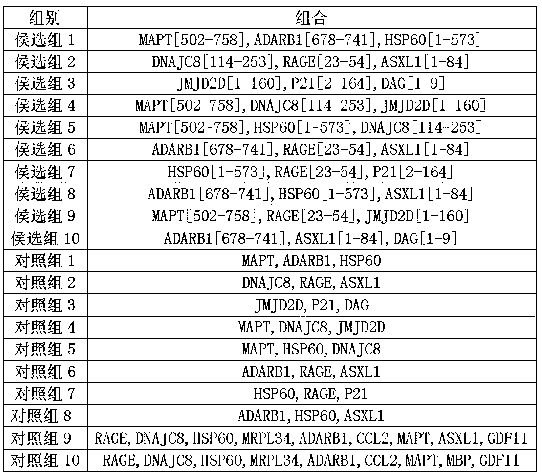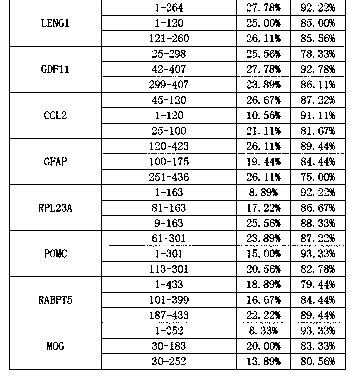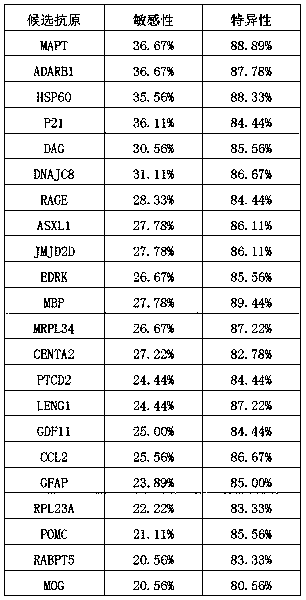Protein antigen composition for detecting Alzheimer's disease autoantibody and application of composition
A technology for Alzheimer's disease and antigens, which is applied in the field of protein antigen combination detection of Alzheimer's disease autoantibodies in human serum samples, and can solve problems such as poor detection effect, large number of protein antigens, and misdiagnosis
- Summary
- Abstract
- Description
- Claims
- Application Information
AI Technical Summary
Problems solved by technology
Method used
Image
Examples
Embodiment 1
[0036] Example 1: Recombinant Vector Construction, Expression and Purification of Antigen
[0037] 1. The choice of antigen. 115 antigenic proteins highly related to Alzheimer's disease were selected for construction, expression and purification. In order to save the length of the article, only 50 of them are representative in this article, and their respective database IDs are shown in Table 1.
[0038] Table 1 Database ID correspondence table of proteins to be tested
[0039]
[0040] 2. Construction and expression of antigen recombinant vector. The target protein antigen was screened from the 50 proteins listed in Table 1. Using the human cDNA library (purchased from Invitrogen) or the whole gene synthetic DNA as a template, primers were designed respectively, and the full-length gene of the protein was cloned into the pET28 plasmid by molecular cloning methods such as PCR, enzyme digestion, and ligation. At the same time, tags such as HIS and c-myc are added to the ...
Embodiment 2
[0043] Example 2: Screening and obtaining candidate antigens from proteins to be tested
[0044] 1. The solutions and reagents used in this example are as follows:
[0045] (1) Coating buffer is PBS buffer, pH=7.4. Its preparation method is: accurately weigh 3.58g Na 2 HPO 4 12H 2 O, 0.23g KH 2 PO 4 2H 2 O, 0.2g KCl, 8.0g NaCl, dissolved in water, dilute to 1L with water.
[0046] (2) Blocking Solution / Sample Diluent / Antibody Diluent: Dissolve 10g of BSA (bovine serum albumin) in the coating buffer, and dilute to 1L with water.
[0047] (3) Washing liquid: ready-to-use. Add 0.5% Tween20 (V / V) to the coating buffer before use, pH=7.4.
[0048] (4) TMB color reagent, purchased from KPL company.
[0049] (5) Termination solution: 1M hydrochloric acid.
[0050] 2. The solid phase is coated with the protein to be tested. The purified protein to be tested obtained in Example 1 was diluted to 5 μg / ml with coating buffer, added to a 96-well plate, 50 μl per well, and coate...
Embodiment 3
[0061] Example 3: Active site screening of candidate antigens
[0062] 1. Analyze the amino acid sequence and structure of the candidate antigens obtained in Example 2, and select different sequence fragments and antigenic epitopes from each of the candidate antigens after a large number of preliminary tests. The selected sequence fragments or full lengths are shown in Table 4.
[0063] Table 4 Correspondence table of sequence fragments intercepted on each candidate antigen
[0064]
[0065] 2. According to the method of Example 1, the protein fragments in Table 4 were constructed, expressed and purified as expression vectors to obtain the constructed protein fragments, and then detected according to the method of Example 2 when each constructed protein fragment was used as an antigen. Sensitivity and Specificity. Similar to Example 1, although some tags are added to each protein fragment here, the purpose of adding tags is mainly to facilitate extraction and identificati...
PUM
 Login to View More
Login to View More Abstract
Description
Claims
Application Information
 Login to View More
Login to View More - R&D
- Intellectual Property
- Life Sciences
- Materials
- Tech Scout
- Unparalleled Data Quality
- Higher Quality Content
- 60% Fewer Hallucinations
Browse by: Latest US Patents, China's latest patents, Technical Efficacy Thesaurus, Application Domain, Technology Topic, Popular Technical Reports.
© 2025 PatSnap. All rights reserved.Legal|Privacy policy|Modern Slavery Act Transparency Statement|Sitemap|About US| Contact US: help@patsnap.com



